Report: Managing Change and Creativity for Organizational Success
VerifiedAdded on 2019/12/03
|9
|3096
|108
Report
AI Summary
This report delves into the critical role of change and creativity within organizations, emphasizing their interconnectedness and impact on innovation. It highlights the need for change in businesses, driven by factors like technological advancements and the pursuit of competitive advantages. The report examines effective change management strategies, including models for structural, process, and people-focused changes, and underscores the importance of employee engagement and communication. It uses Tesco as a case study, illustrating how adapting to change leads to improvements in employee performance, increased efficiency, and greater innovation. The report also acknowledges the resistance to change and stresses the importance of proactive management and motivational techniques to ensure successful implementation, ultimately leading to growth and development.
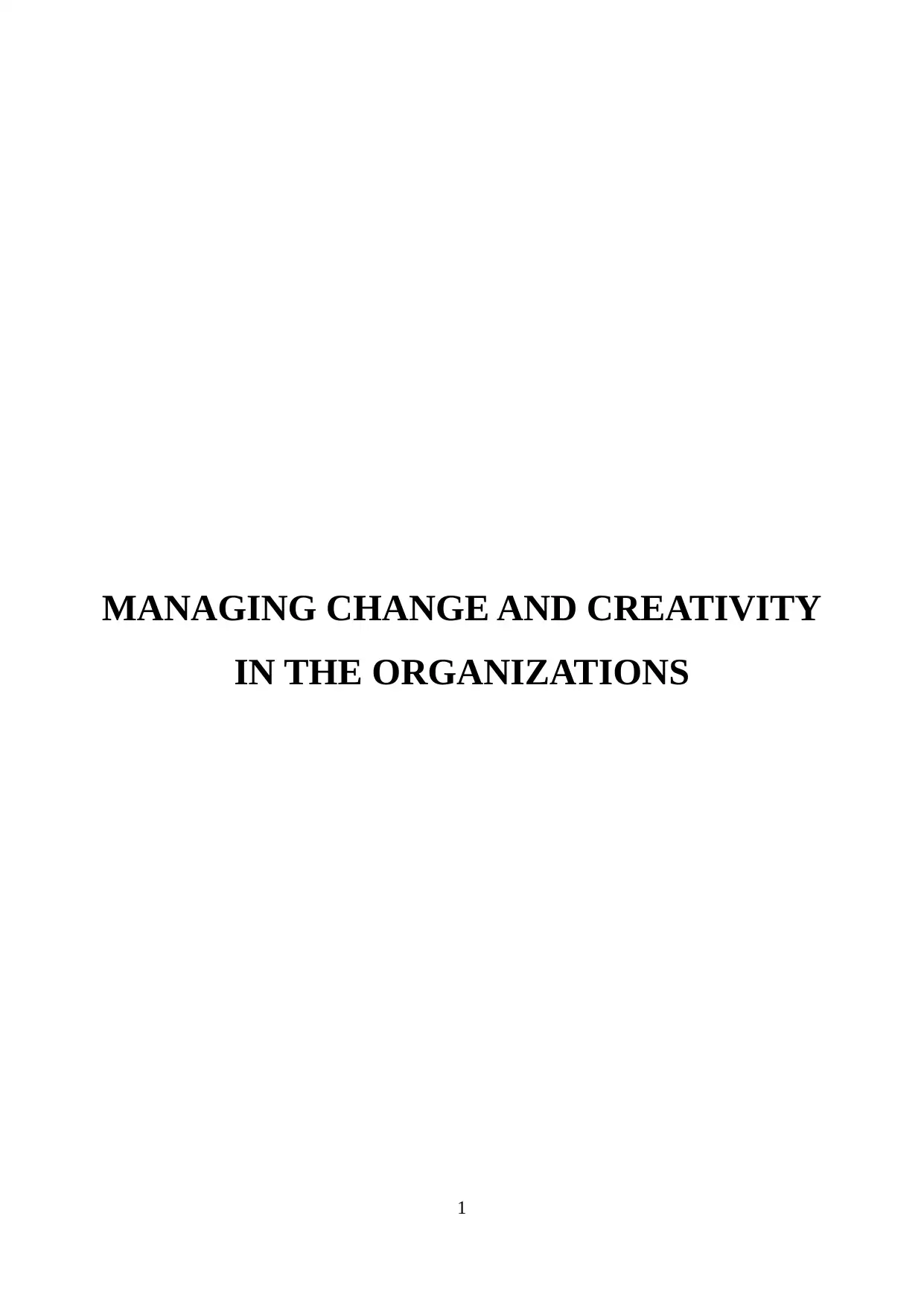
MANAGING CHANGE AND CREATIVITY
IN THE ORGANIZATIONS
1
IN THE ORGANIZATIONS
1
Paraphrase This Document
Need a fresh take? Get an instant paraphrase of this document with our AI Paraphraser
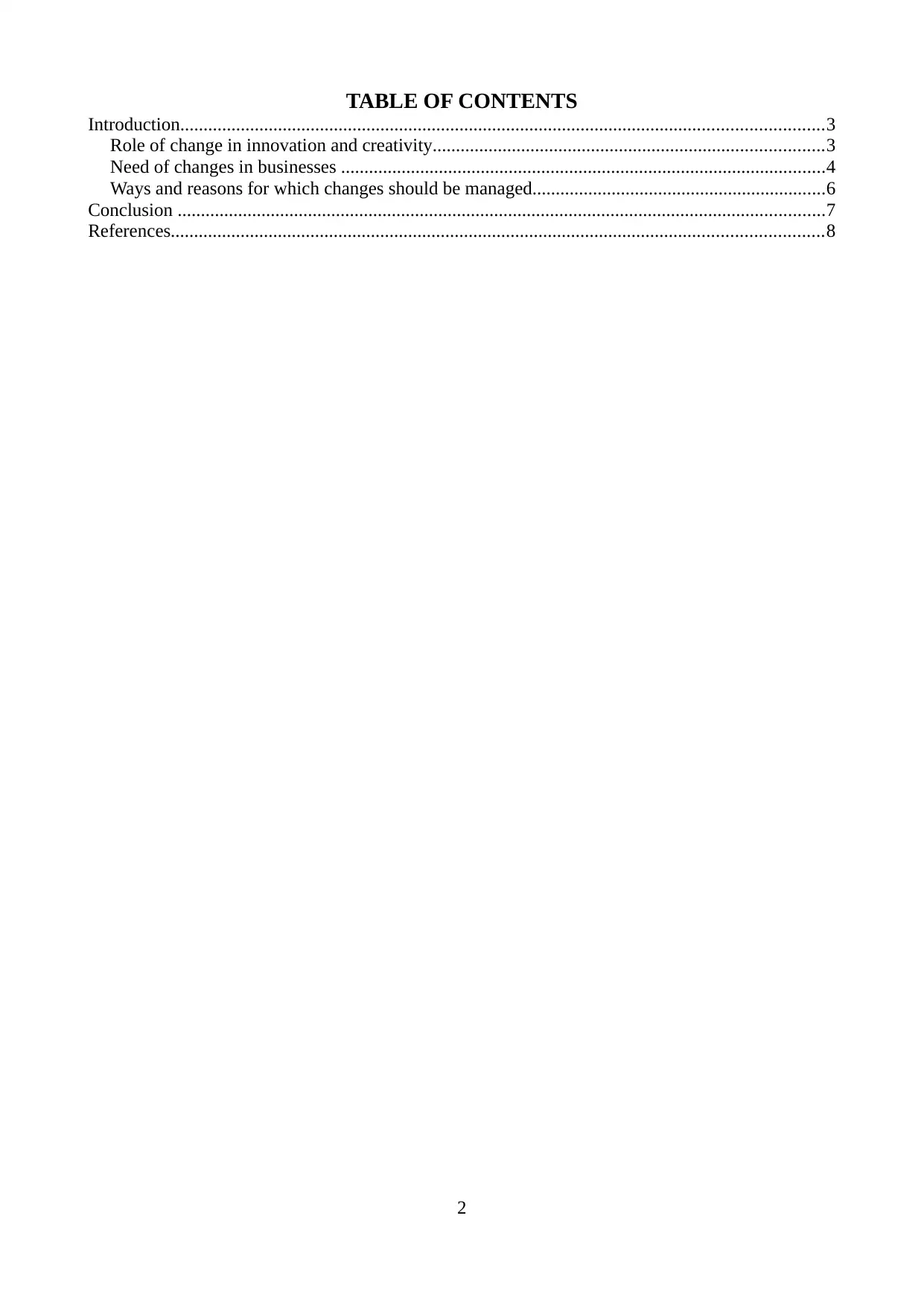
TABLE OF CONTENTS
Introduction..........................................................................................................................................3
Role of change in innovation and creativity....................................................................................3
Need of changes in businesses ........................................................................................................4
Ways and reasons for which changes should be managed...............................................................6
Conclusion ...........................................................................................................................................7
References............................................................................................................................................8
2
Introduction..........................................................................................................................................3
Role of change in innovation and creativity....................................................................................3
Need of changes in businesses ........................................................................................................4
Ways and reasons for which changes should be managed...............................................................6
Conclusion ...........................................................................................................................................7
References............................................................................................................................................8
2
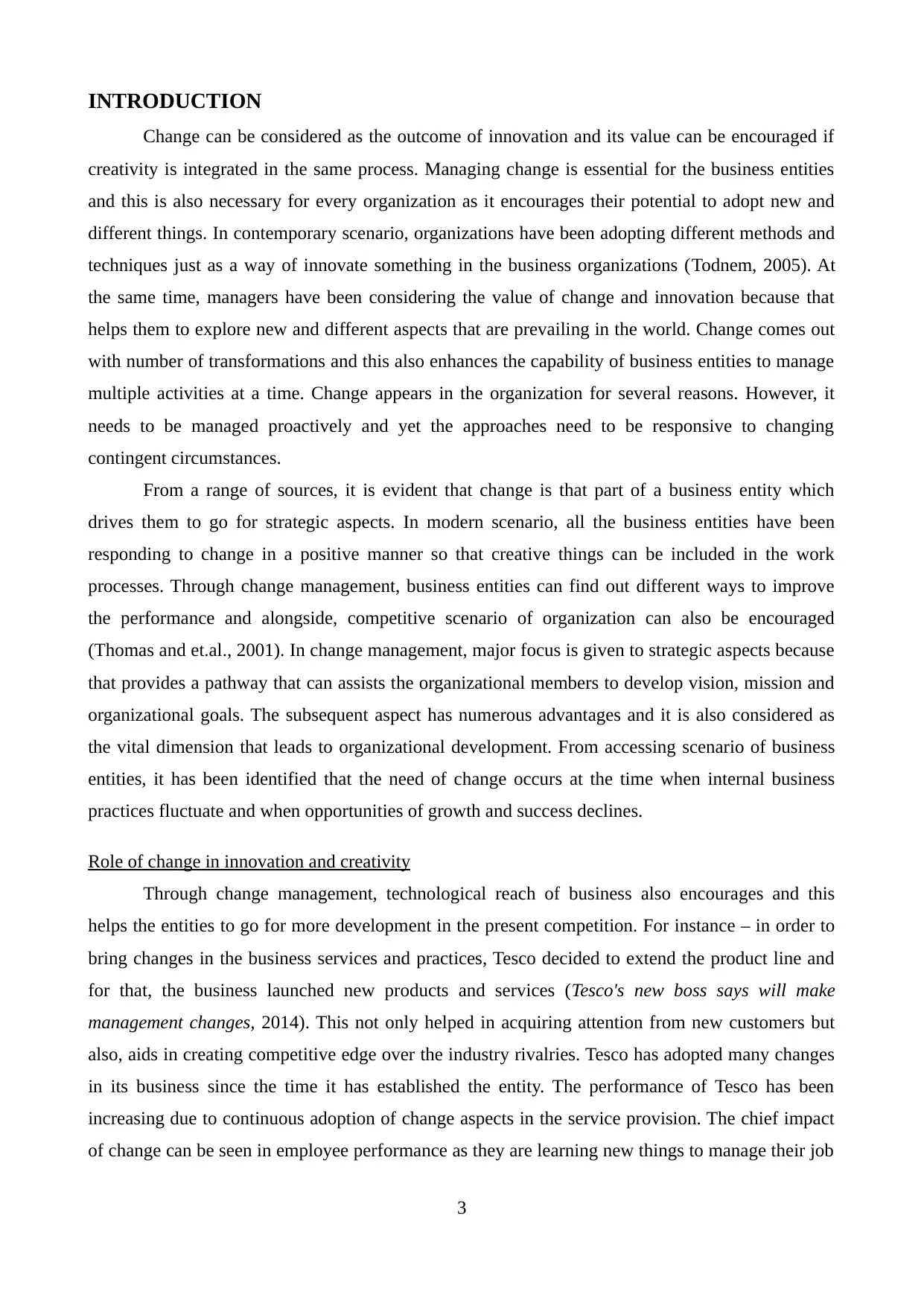
INTRODUCTION
Change can be considered as the outcome of innovation and its value can be encouraged if
creativity is integrated in the same process. Managing change is essential for the business entities
and this is also necessary for every organization as it encourages their potential to adopt new and
different things. In contemporary scenario, organizations have been adopting different methods and
techniques just as a way of innovate something in the business organizations (Todnem, 2005). At
the same time, managers have been considering the value of change and innovation because that
helps them to explore new and different aspects that are prevailing in the world. Change comes out
with number of transformations and this also enhances the capability of business entities to manage
multiple activities at a time. Change appears in the organization for several reasons. However, it
needs to be managed proactively and yet the approaches need to be responsive to changing
contingent circumstances.
From a range of sources, it is evident that change is that part of a business entity which
drives them to go for strategic aspects. In modern scenario, all the business entities have been
responding to change in a positive manner so that creative things can be included in the work
processes. Through change management, business entities can find out different ways to improve
the performance and alongside, competitive scenario of organization can also be encouraged
(Thomas and et.al., 2001). In change management, major focus is given to strategic aspects because
that provides a pathway that can assists the organizational members to develop vision, mission and
organizational goals. The subsequent aspect has numerous advantages and it is also considered as
the vital dimension that leads to organizational development. From accessing scenario of business
entities, it has been identified that the need of change occurs at the time when internal business
practices fluctuate and when opportunities of growth and success declines.
Role of change in innovation and creativity
Through change management, technological reach of business also encourages and this
helps the entities to go for more development in the present competition. For instance – in order to
bring changes in the business services and practices, Tesco decided to extend the product line and
for that, the business launched new products and services (Tesco's new boss says will make
management changes, 2014). This not only helped in acquiring attention from new customers but
also, aids in creating competitive edge over the industry rivalries. Tesco has adopted many changes
in its business since the time it has established the entity. The performance of Tesco has been
increasing due to continuous adoption of change aspects in the service provision. The chief impact
of change can be seen in employee performance as they are learning new things to manage their job
3
Change can be considered as the outcome of innovation and its value can be encouraged if
creativity is integrated in the same process. Managing change is essential for the business entities
and this is also necessary for every organization as it encourages their potential to adopt new and
different things. In contemporary scenario, organizations have been adopting different methods and
techniques just as a way of innovate something in the business organizations (Todnem, 2005). At
the same time, managers have been considering the value of change and innovation because that
helps them to explore new and different aspects that are prevailing in the world. Change comes out
with number of transformations and this also enhances the capability of business entities to manage
multiple activities at a time. Change appears in the organization for several reasons. However, it
needs to be managed proactively and yet the approaches need to be responsive to changing
contingent circumstances.
From a range of sources, it is evident that change is that part of a business entity which
drives them to go for strategic aspects. In modern scenario, all the business entities have been
responding to change in a positive manner so that creative things can be included in the work
processes. Through change management, business entities can find out different ways to improve
the performance and alongside, competitive scenario of organization can also be encouraged
(Thomas and et.al., 2001). In change management, major focus is given to strategic aspects because
that provides a pathway that can assists the organizational members to develop vision, mission and
organizational goals. The subsequent aspect has numerous advantages and it is also considered as
the vital dimension that leads to organizational development. From accessing scenario of business
entities, it has been identified that the need of change occurs at the time when internal business
practices fluctuate and when opportunities of growth and success declines.
Role of change in innovation and creativity
Through change management, technological reach of business also encourages and this
helps the entities to go for more development in the present competition. For instance – in order to
bring changes in the business services and practices, Tesco decided to extend the product line and
for that, the business launched new products and services (Tesco's new boss says will make
management changes, 2014). This not only helped in acquiring attention from new customers but
also, aids in creating competitive edge over the industry rivalries. Tesco has adopted many changes
in its business since the time it has established the entity. The performance of Tesco has been
increasing due to continuous adoption of change aspects in the service provision. The chief impact
of change can be seen in employee performance as they are learning new things to manage their job
3
⊘ This is a preview!⊘
Do you want full access?
Subscribe today to unlock all pages.

Trusted by 1+ million students worldwide
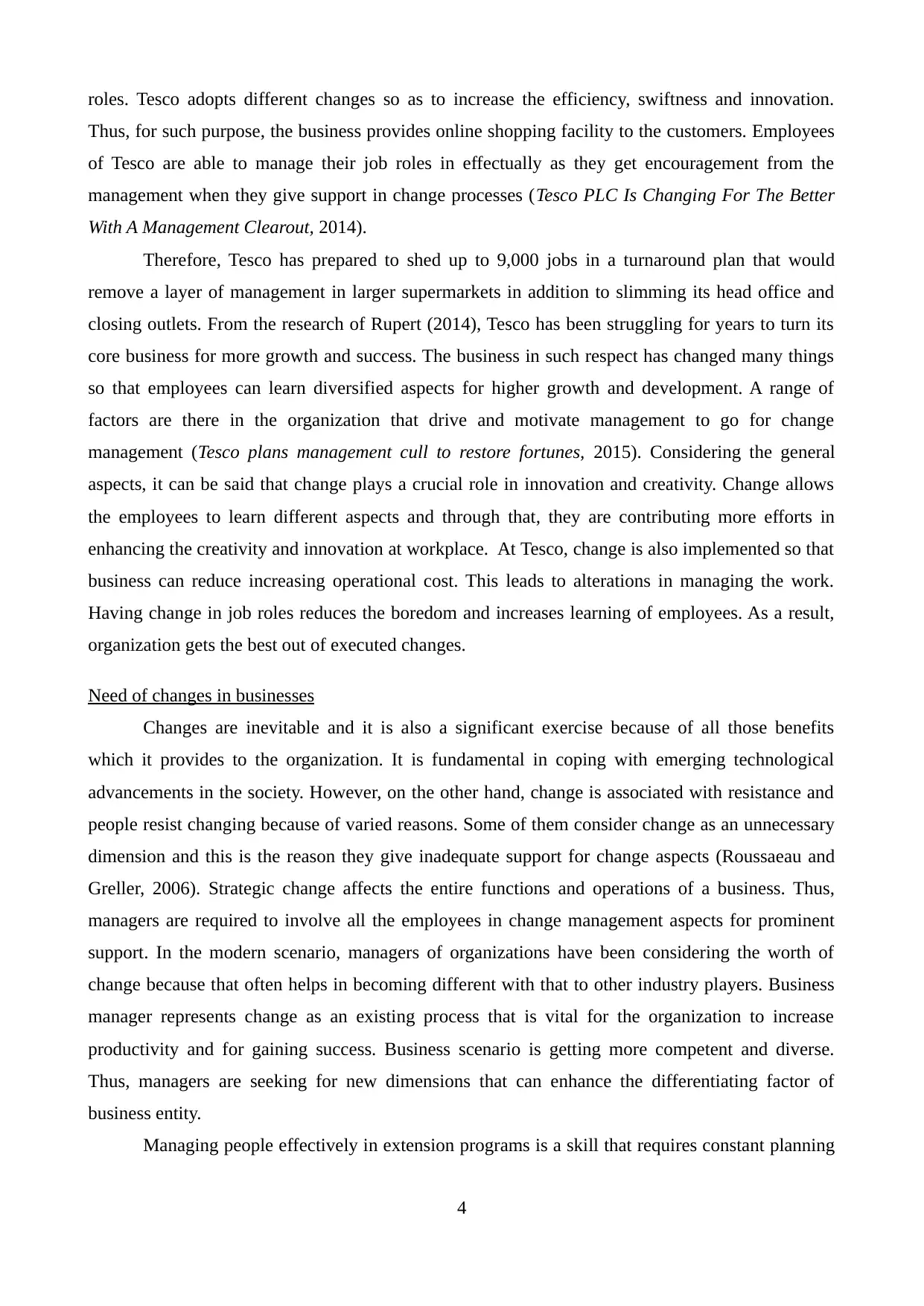
roles. Tesco adopts different changes so as to increase the efficiency, swiftness and innovation.
Thus, for such purpose, the business provides online shopping facility to the customers. Employees
of Tesco are able to manage their job roles in effectually as they get encouragement from the
management when they give support in change processes (Tesco PLC Is Changing For The Better
With A Management Clearout, 2014).
Therefore, Tesco has prepared to shed up to 9,000 jobs in a turnaround plan that would
remove a layer of management in larger supermarkets in addition to slimming its head office and
closing outlets. From the research of Rupert (2014), Tesco has been struggling for years to turn its
core business for more growth and success. The business in such respect has changed many things
so that employees can learn diversified aspects for higher growth and development. A range of
factors are there in the organization that drive and motivate management to go for change
management (Tesco plans management cull to restore fortunes, 2015). Considering the general
aspects, it can be said that change plays a crucial role in innovation and creativity. Change allows
the employees to learn different aspects and through that, they are contributing more efforts in
enhancing the creativity and innovation at workplace. At Tesco, change is also implemented so that
business can reduce increasing operational cost. This leads to alterations in managing the work.
Having change in job roles reduces the boredom and increases learning of employees. As a result,
organization gets the best out of executed changes.
Need of changes in businesses
Changes are inevitable and it is also a significant exercise because of all those benefits
which it provides to the organization. It is fundamental in coping with emerging technological
advancements in the society. However, on the other hand, change is associated with resistance and
people resist changing because of varied reasons. Some of them consider change as an unnecessary
dimension and this is the reason they give inadequate support for change aspects (Roussaeau and
Greller, 2006). Strategic change affects the entire functions and operations of a business. Thus,
managers are required to involve all the employees in change management aspects for prominent
support. In the modern scenario, managers of organizations have been considering the worth of
change because that often helps in becoming different with that to other industry players. Business
manager represents change as an existing process that is vital for the organization to increase
productivity and for gaining success. Business scenario is getting more competent and diverse.
Thus, managers are seeking for new dimensions that can enhance the differentiating factor of
business entity.
Managing people effectively in extension programs is a skill that requires constant planning
4
Thus, for such purpose, the business provides online shopping facility to the customers. Employees
of Tesco are able to manage their job roles in effectually as they get encouragement from the
management when they give support in change processes (Tesco PLC Is Changing For The Better
With A Management Clearout, 2014).
Therefore, Tesco has prepared to shed up to 9,000 jobs in a turnaround plan that would
remove a layer of management in larger supermarkets in addition to slimming its head office and
closing outlets. From the research of Rupert (2014), Tesco has been struggling for years to turn its
core business for more growth and success. The business in such respect has changed many things
so that employees can learn diversified aspects for higher growth and development. A range of
factors are there in the organization that drive and motivate management to go for change
management (Tesco plans management cull to restore fortunes, 2015). Considering the general
aspects, it can be said that change plays a crucial role in innovation and creativity. Change allows
the employees to learn different aspects and through that, they are contributing more efforts in
enhancing the creativity and innovation at workplace. At Tesco, change is also implemented so that
business can reduce increasing operational cost. This leads to alterations in managing the work.
Having change in job roles reduces the boredom and increases learning of employees. As a result,
organization gets the best out of executed changes.
Need of changes in businesses
Changes are inevitable and it is also a significant exercise because of all those benefits
which it provides to the organization. It is fundamental in coping with emerging technological
advancements in the society. However, on the other hand, change is associated with resistance and
people resist changing because of varied reasons. Some of them consider change as an unnecessary
dimension and this is the reason they give inadequate support for change aspects (Roussaeau and
Greller, 2006). Strategic change affects the entire functions and operations of a business. Thus,
managers are required to involve all the employees in change management aspects for prominent
support. In the modern scenario, managers of organizations have been considering the worth of
change because that often helps in becoming different with that to other industry players. Business
manager represents change as an existing process that is vital for the organization to increase
productivity and for gaining success. Business scenario is getting more competent and diverse.
Thus, managers are seeking for new dimensions that can enhance the differentiating factor of
business entity.
Managing people effectively in extension programs is a skill that requires constant planning
4
Paraphrase This Document
Need a fresh take? Get an instant paraphrase of this document with our AI Paraphraser
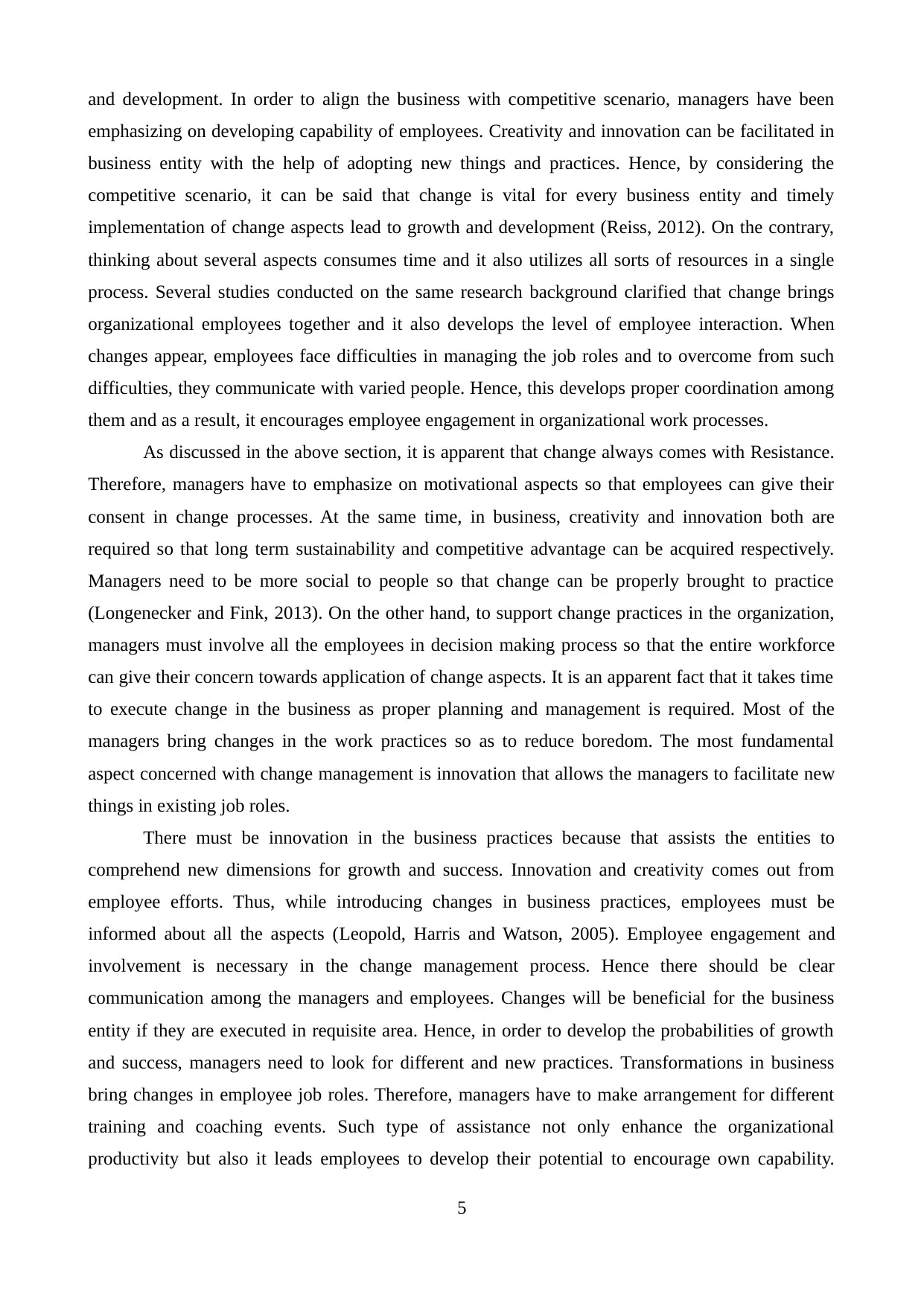
and development. In order to align the business with competitive scenario, managers have been
emphasizing on developing capability of employees. Creativity and innovation can be facilitated in
business entity with the help of adopting new things and practices. Hence, by considering the
competitive scenario, it can be said that change is vital for every business entity and timely
implementation of change aspects lead to growth and development (Reiss, 2012). On the contrary,
thinking about several aspects consumes time and it also utilizes all sorts of resources in a single
process. Several studies conducted on the same research background clarified that change brings
organizational employees together and it also develops the level of employee interaction. When
changes appear, employees face difficulties in managing the job roles and to overcome from such
difficulties, they communicate with varied people. Hence, this develops proper coordination among
them and as a result, it encourages employee engagement in organizational work processes.
As discussed in the above section, it is apparent that change always comes with Resistance.
Therefore, managers have to emphasize on motivational aspects so that employees can give their
consent in change processes. At the same time, in business, creativity and innovation both are
required so that long term sustainability and competitive advantage can be acquired respectively.
Managers need to be more social to people so that change can be properly brought to practice
(Longenecker and Fink, 2013). On the other hand, to support change practices in the organization,
managers must involve all the employees in decision making process so that the entire workforce
can give their concern towards application of change aspects. It is an apparent fact that it takes time
to execute change in the business as proper planning and management is required. Most of the
managers bring changes in the work practices so as to reduce boredom. The most fundamental
aspect concerned with change management is innovation that allows the managers to facilitate new
things in existing job roles.
There must be innovation in the business practices because that assists the entities to
comprehend new dimensions for growth and success. Innovation and creativity comes out from
employee efforts. Thus, while introducing changes in business practices, employees must be
informed about all the aspects (Leopold, Harris and Watson, 2005). Employee engagement and
involvement is necessary in the change management process. Hence there should be clear
communication among the managers and employees. Changes will be beneficial for the business
entity if they are executed in requisite area. Hence, in order to develop the probabilities of growth
and success, managers need to look for different and new practices. Transformations in business
bring changes in employee job roles. Therefore, managers have to make arrangement for different
training and coaching events. Such type of assistance not only enhance the organizational
productivity but also it leads employees to develop their potential to encourage own capability.
5
emphasizing on developing capability of employees. Creativity and innovation can be facilitated in
business entity with the help of adopting new things and practices. Hence, by considering the
competitive scenario, it can be said that change is vital for every business entity and timely
implementation of change aspects lead to growth and development (Reiss, 2012). On the contrary,
thinking about several aspects consumes time and it also utilizes all sorts of resources in a single
process. Several studies conducted on the same research background clarified that change brings
organizational employees together and it also develops the level of employee interaction. When
changes appear, employees face difficulties in managing the job roles and to overcome from such
difficulties, they communicate with varied people. Hence, this develops proper coordination among
them and as a result, it encourages employee engagement in organizational work processes.
As discussed in the above section, it is apparent that change always comes with Resistance.
Therefore, managers have to emphasize on motivational aspects so that employees can give their
consent in change processes. At the same time, in business, creativity and innovation both are
required so that long term sustainability and competitive advantage can be acquired respectively.
Managers need to be more social to people so that change can be properly brought to practice
(Longenecker and Fink, 2013). On the other hand, to support change practices in the organization,
managers must involve all the employees in decision making process so that the entire workforce
can give their concern towards application of change aspects. It is an apparent fact that it takes time
to execute change in the business as proper planning and management is required. Most of the
managers bring changes in the work practices so as to reduce boredom. The most fundamental
aspect concerned with change management is innovation that allows the managers to facilitate new
things in existing job roles.
There must be innovation in the business practices because that assists the entities to
comprehend new dimensions for growth and success. Innovation and creativity comes out from
employee efforts. Thus, while introducing changes in business practices, employees must be
informed about all the aspects (Leopold, Harris and Watson, 2005). Employee engagement and
involvement is necessary in the change management process. Hence there should be clear
communication among the managers and employees. Changes will be beneficial for the business
entity if they are executed in requisite area. Hence, in order to develop the probabilities of growth
and success, managers need to look for different and new practices. Transformations in business
bring changes in employee job roles. Therefore, managers have to make arrangement for different
training and coaching events. Such type of assistance not only enhance the organizational
productivity but also it leads employees to develop their potential to encourage own capability.
5
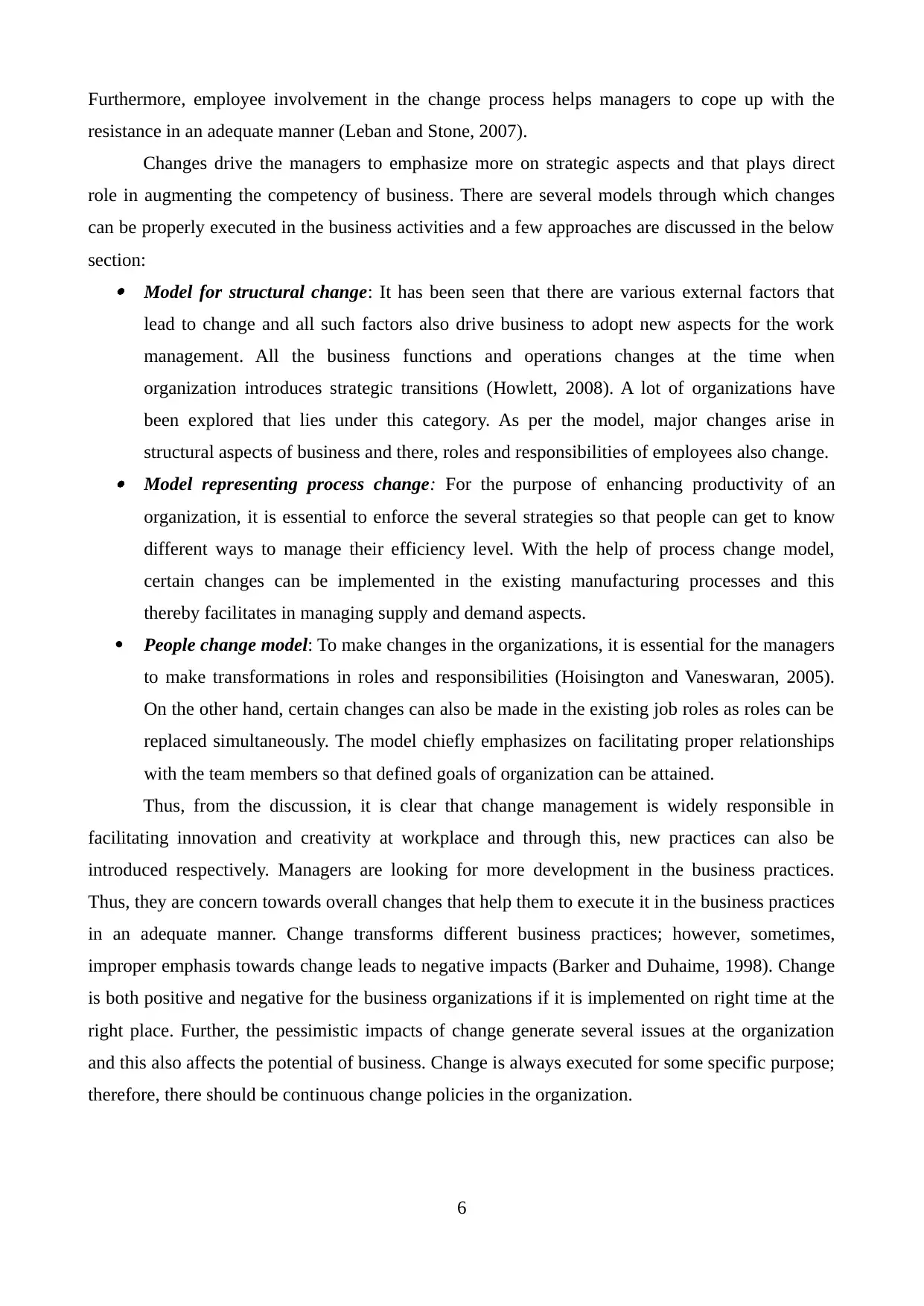
Furthermore, employee involvement in the change process helps managers to cope up with the
resistance in an adequate manner (Leban and Stone, 2007).
Changes drive the managers to emphasize more on strategic aspects and that plays direct
role in augmenting the competency of business. There are several models through which changes
can be properly executed in the business activities and a few approaches are discussed in the below
section: Model for structural change: It has been seen that there are various external factors that
lead to change and all such factors also drive business to adopt new aspects for the work
management. All the business functions and operations changes at the time when
organization introduces strategic transitions (Howlett, 2008). A lot of organizations have
been explored that lies under this category. As per the model, major changes arise in
structural aspects of business and there, roles and responsibilities of employees also change. Model representing process change: For the purpose of enhancing productivity of an
organization, it is essential to enforce the several strategies so that people can get to know
different ways to manage their efficiency level. With the help of process change model,
certain changes can be implemented in the existing manufacturing processes and this
thereby facilitates in managing supply and demand aspects.
People change model: To make changes in the organizations, it is essential for the managers
to make transformations in roles and responsibilities (Hoisington and Vaneswaran, 2005).
On the other hand, certain changes can also be made in the existing job roles as roles can be
replaced simultaneously. The model chiefly emphasizes on facilitating proper relationships
with the team members so that defined goals of organization can be attained.
Thus, from the discussion, it is clear that change management is widely responsible in
facilitating innovation and creativity at workplace and through this, new practices can also be
introduced respectively. Managers are looking for more development in the business practices.
Thus, they are concern towards overall changes that help them to execute it in the business practices
in an adequate manner. Change transforms different business practices; however, sometimes,
improper emphasis towards change leads to negative impacts (Barker and Duhaime, 1998). Change
is both positive and negative for the business organizations if it is implemented on right time at the
right place. Further, the pessimistic impacts of change generate several issues at the organization
and this also affects the potential of business. Change is always executed for some specific purpose;
therefore, there should be continuous change policies in the organization.
6
resistance in an adequate manner (Leban and Stone, 2007).
Changes drive the managers to emphasize more on strategic aspects and that plays direct
role in augmenting the competency of business. There are several models through which changes
can be properly executed in the business activities and a few approaches are discussed in the below
section: Model for structural change: It has been seen that there are various external factors that
lead to change and all such factors also drive business to adopt new aspects for the work
management. All the business functions and operations changes at the time when
organization introduces strategic transitions (Howlett, 2008). A lot of organizations have
been explored that lies under this category. As per the model, major changes arise in
structural aspects of business and there, roles and responsibilities of employees also change. Model representing process change: For the purpose of enhancing productivity of an
organization, it is essential to enforce the several strategies so that people can get to know
different ways to manage their efficiency level. With the help of process change model,
certain changes can be implemented in the existing manufacturing processes and this
thereby facilitates in managing supply and demand aspects.
People change model: To make changes in the organizations, it is essential for the managers
to make transformations in roles and responsibilities (Hoisington and Vaneswaran, 2005).
On the other hand, certain changes can also be made in the existing job roles as roles can be
replaced simultaneously. The model chiefly emphasizes on facilitating proper relationships
with the team members so that defined goals of organization can be attained.
Thus, from the discussion, it is clear that change management is widely responsible in
facilitating innovation and creativity at workplace and through this, new practices can also be
introduced respectively. Managers are looking for more development in the business practices.
Thus, they are concern towards overall changes that help them to execute it in the business practices
in an adequate manner. Change transforms different business practices; however, sometimes,
improper emphasis towards change leads to negative impacts (Barker and Duhaime, 1998). Change
is both positive and negative for the business organizations if it is implemented on right time at the
right place. Further, the pessimistic impacts of change generate several issues at the organization
and this also affects the potential of business. Change is always executed for some specific purpose;
therefore, there should be continuous change policies in the organization.
6
⊘ This is a preview!⊘
Do you want full access?
Subscribe today to unlock all pages.

Trusted by 1+ million students worldwide
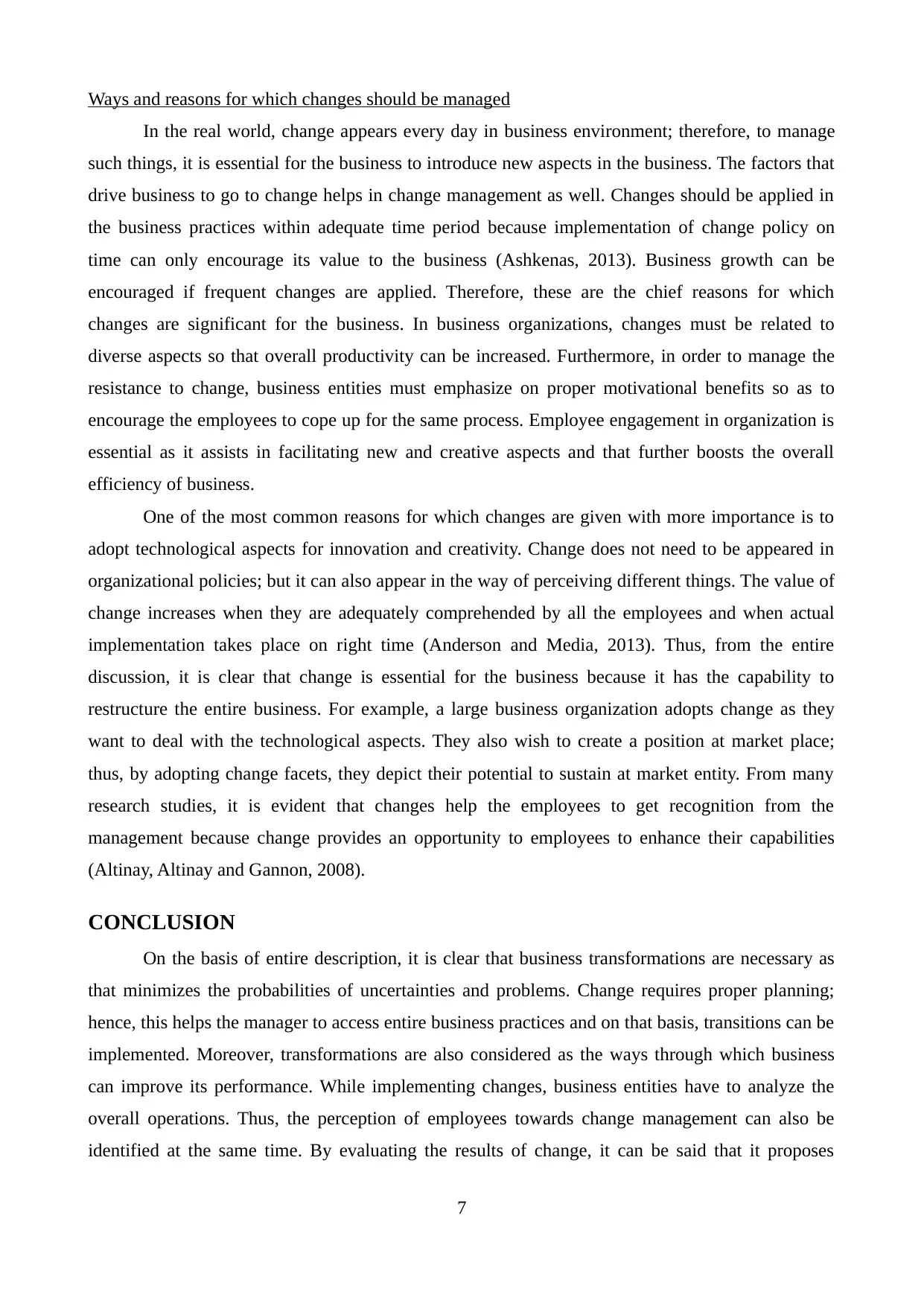
Ways and reasons for which changes should be managed
In the real world, change appears every day in business environment; therefore, to manage
such things, it is essential for the business to introduce new aspects in the business. The factors that
drive business to go to change helps in change management as well. Changes should be applied in
the business practices within adequate time period because implementation of change policy on
time can only encourage its value to the business (Ashkenas, 2013). Business growth can be
encouraged if frequent changes are applied. Therefore, these are the chief reasons for which
changes are significant for the business. In business organizations, changes must be related to
diverse aspects so that overall productivity can be increased. Furthermore, in order to manage the
resistance to change, business entities must emphasize on proper motivational benefits so as to
encourage the employees to cope up for the same process. Employee engagement in organization is
essential as it assists in facilitating new and creative aspects and that further boosts the overall
efficiency of business.
One of the most common reasons for which changes are given with more importance is to
adopt technological aspects for innovation and creativity. Change does not need to be appeared in
organizational policies; but it can also appear in the way of perceiving different things. The value of
change increases when they are adequately comprehended by all the employees and when actual
implementation takes place on right time (Anderson and Media, 2013). Thus, from the entire
discussion, it is clear that change is essential for the business because it has the capability to
restructure the entire business. For example, a large business organization adopts change as they
want to deal with the technological aspects. They also wish to create a position at market place;
thus, by adopting change facets, they depict their potential to sustain at market entity. From many
research studies, it is evident that changes help the employees to get recognition from the
management because change provides an opportunity to employees to enhance their capabilities
(Altinay, Altinay and Gannon, 2008).
CONCLUSION
On the basis of entire description, it is clear that business transformations are necessary as
that minimizes the probabilities of uncertainties and problems. Change requires proper planning;
hence, this helps the manager to access entire business practices and on that basis, transitions can be
implemented. Moreover, transformations are also considered as the ways through which business
can improve its performance. While implementing changes, business entities have to analyze the
overall operations. Thus, the perception of employees towards change management can also be
identified at the same time. By evaluating the results of change, it can be said that it proposes
7
In the real world, change appears every day in business environment; therefore, to manage
such things, it is essential for the business to introduce new aspects in the business. The factors that
drive business to go to change helps in change management as well. Changes should be applied in
the business practices within adequate time period because implementation of change policy on
time can only encourage its value to the business (Ashkenas, 2013). Business growth can be
encouraged if frequent changes are applied. Therefore, these are the chief reasons for which
changes are significant for the business. In business organizations, changes must be related to
diverse aspects so that overall productivity can be increased. Furthermore, in order to manage the
resistance to change, business entities must emphasize on proper motivational benefits so as to
encourage the employees to cope up for the same process. Employee engagement in organization is
essential as it assists in facilitating new and creative aspects and that further boosts the overall
efficiency of business.
One of the most common reasons for which changes are given with more importance is to
adopt technological aspects for innovation and creativity. Change does not need to be appeared in
organizational policies; but it can also appear in the way of perceiving different things. The value of
change increases when they are adequately comprehended by all the employees and when actual
implementation takes place on right time (Anderson and Media, 2013). Thus, from the entire
discussion, it is clear that change is essential for the business because it has the capability to
restructure the entire business. For example, a large business organization adopts change as they
want to deal with the technological aspects. They also wish to create a position at market place;
thus, by adopting change facets, they depict their potential to sustain at market entity. From many
research studies, it is evident that changes help the employees to get recognition from the
management because change provides an opportunity to employees to enhance their capabilities
(Altinay, Altinay and Gannon, 2008).
CONCLUSION
On the basis of entire description, it is clear that business transformations are necessary as
that minimizes the probabilities of uncertainties and problems. Change requires proper planning;
hence, this helps the manager to access entire business practices and on that basis, transitions can be
implemented. Moreover, transformations are also considered as the ways through which business
can improve its performance. While implementing changes, business entities have to analyze the
overall operations. Thus, the perception of employees towards change management can also be
identified at the same time. By evaluating the results of change, it can be said that it proposes
7
Paraphrase This Document
Need a fresh take? Get an instant paraphrase of this document with our AI Paraphraser
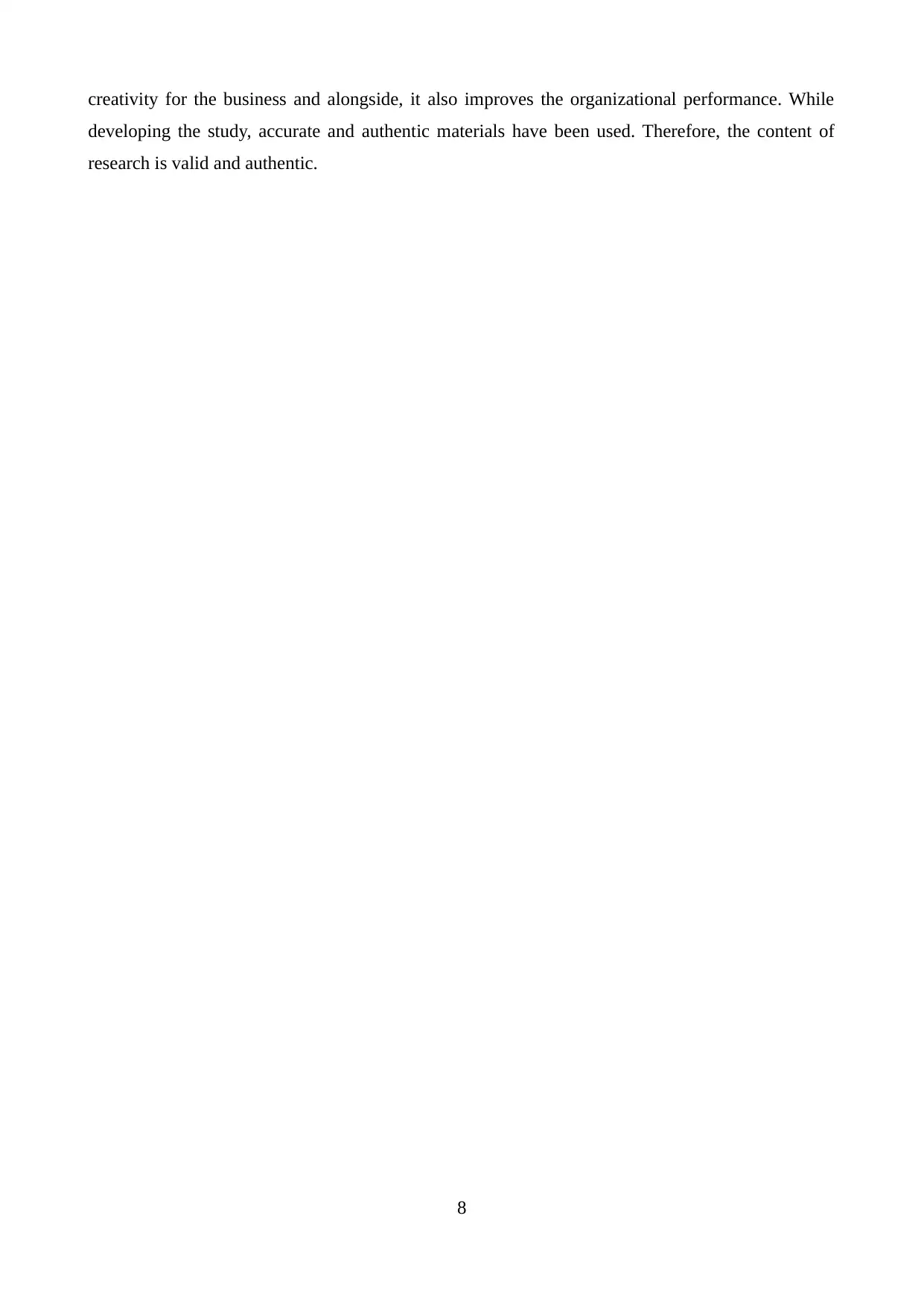
creativity for the business and alongside, it also improves the organizational performance. While
developing the study, accurate and authentic materials have been used. Therefore, the content of
research is valid and authentic.
8
developing the study, accurate and authentic materials have been used. Therefore, the content of
research is valid and authentic.
8
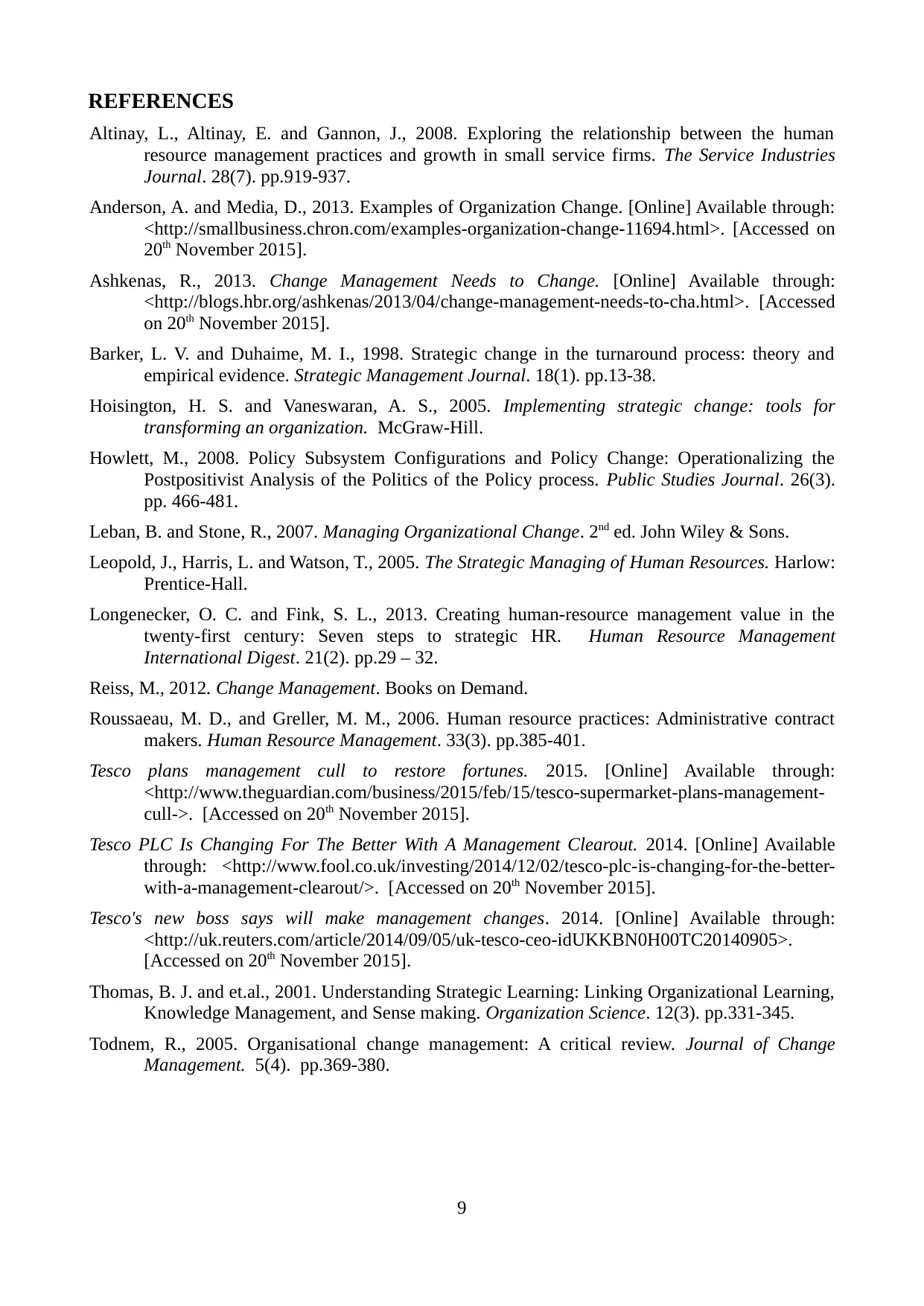
REFERENCES
Altinay, L., Altinay, E. and Gannon, J., 2008. Exploring the relationship between the human
resource management practices and growth in small service firms. The Service Industries
Journal. 28(7). pp.919-937.
Anderson, A. and Media, D., 2013. Examples of Organization Change. [Online] Available through:
<http://smallbusiness.chron.com/examples-organization-change-11694.html>. [Accessed on
20th November 2015].
Ashkenas, R., 2013. Change Management Needs to Change. [Online] Available through:
<http://blogs.hbr.org/ashkenas/2013/04/change-management-needs-to-cha.html>. [Accessed
on 20th November 2015].
Barker, L. V. and Duhaime, M. I., 1998. Strategic change in the turnaround process: theory and
empirical evidence. Strategic Management Journal. 18(1). pp.13-38.
Hoisington, H. S. and Vaneswaran, A. S., 2005. Implementing strategic change: tools for
transforming an organization. McGraw-Hill.
Howlett, M., 2008. Policy Subsystem Configurations and Policy Change: Operationalizing the
Postpositivist Analysis of the Politics of the Policy process. Public Studies Journal. 26(3).
pp. 466-481.
Leban, B. and Stone, R., 2007. Managing Organizational Change. 2nd ed. John Wiley & Sons.
Leopold, J., Harris, L. and Watson, T., 2005. The Strategic Managing of Human Resources. Harlow:
Prentice-Hall.
Longenecker, O. C. and Fink, S. L., 2013. Creating human-resource management value in the
twenty-first century: Seven steps to strategic HR. Human Resource Management
International Digest. 21(2). pp.29 – 32.
Reiss, M., 2012. Change Management. Books on Demand.
Roussaeau, M. D., and Greller, M. M., 2006. Human resource practices: Administrative contract
makers. Human Resource Management. 33(3). pp.385-401.
Tesco plans management cull to restore fortunes. 2015. [Online] Available through:
<http://www.theguardian.com/business/2015/feb/15/tesco-supermarket-plans-management-
cull->. [Accessed on 20th November 2015].
Tesco PLC Is Changing For The Better With A Management Clearout. 2014. [Online] Available
through: <http://www.fool.co.uk/investing/2014/12/02/tesco-plc-is-changing-for-the-better-
with-a-management-clearout/>. [Accessed on 20th November 2015].
Tesco's new boss says will make management changes. 2014. [Online] Available through:
<http://uk.reuters.com/article/2014/09/05/uk-tesco-ceo-idUKKBN0H00TC20140905>.
[Accessed on 20th November 2015].
Thomas, B. J. and et.al., 2001. Understanding Strategic Learning: Linking Organizational Learning,
Knowledge Management, and Sense making. Organization Science. 12(3). pp.331-345.
Todnem, R., 2005. Organisational change management: A critical review. Journal of Change
Management. 5(4). pp.369-380.
9
Altinay, L., Altinay, E. and Gannon, J., 2008. Exploring the relationship between the human
resource management practices and growth in small service firms. The Service Industries
Journal. 28(7). pp.919-937.
Anderson, A. and Media, D., 2013. Examples of Organization Change. [Online] Available through:
<http://smallbusiness.chron.com/examples-organization-change-11694.html>. [Accessed on
20th November 2015].
Ashkenas, R., 2013. Change Management Needs to Change. [Online] Available through:
<http://blogs.hbr.org/ashkenas/2013/04/change-management-needs-to-cha.html>. [Accessed
on 20th November 2015].
Barker, L. V. and Duhaime, M. I., 1998. Strategic change in the turnaround process: theory and
empirical evidence. Strategic Management Journal. 18(1). pp.13-38.
Hoisington, H. S. and Vaneswaran, A. S., 2005. Implementing strategic change: tools for
transforming an organization. McGraw-Hill.
Howlett, M., 2008. Policy Subsystem Configurations and Policy Change: Operationalizing the
Postpositivist Analysis of the Politics of the Policy process. Public Studies Journal. 26(3).
pp. 466-481.
Leban, B. and Stone, R., 2007. Managing Organizational Change. 2nd ed. John Wiley & Sons.
Leopold, J., Harris, L. and Watson, T., 2005. The Strategic Managing of Human Resources. Harlow:
Prentice-Hall.
Longenecker, O. C. and Fink, S. L., 2013. Creating human-resource management value in the
twenty-first century: Seven steps to strategic HR. Human Resource Management
International Digest. 21(2). pp.29 – 32.
Reiss, M., 2012. Change Management. Books on Demand.
Roussaeau, M. D., and Greller, M. M., 2006. Human resource practices: Administrative contract
makers. Human Resource Management. 33(3). pp.385-401.
Tesco plans management cull to restore fortunes. 2015. [Online] Available through:
<http://www.theguardian.com/business/2015/feb/15/tesco-supermarket-plans-management-
cull->. [Accessed on 20th November 2015].
Tesco PLC Is Changing For The Better With A Management Clearout. 2014. [Online] Available
through: <http://www.fool.co.uk/investing/2014/12/02/tesco-plc-is-changing-for-the-better-
with-a-management-clearout/>. [Accessed on 20th November 2015].
Tesco's new boss says will make management changes. 2014. [Online] Available through:
<http://uk.reuters.com/article/2014/09/05/uk-tesco-ceo-idUKKBN0H00TC20140905>.
[Accessed on 20th November 2015].
Thomas, B. J. and et.al., 2001. Understanding Strategic Learning: Linking Organizational Learning,
Knowledge Management, and Sense making. Organization Science. 12(3). pp.331-345.
Todnem, R., 2005. Organisational change management: A critical review. Journal of Change
Management. 5(4). pp.369-380.
9
⊘ This is a preview!⊘
Do you want full access?
Subscribe today to unlock all pages.

Trusted by 1+ million students worldwide
1 out of 9
Related Documents
Your All-in-One AI-Powered Toolkit for Academic Success.
+13062052269
info@desklib.com
Available 24*7 on WhatsApp / Email
![[object Object]](/_next/static/media/star-bottom.7253800d.svg)
Unlock your academic potential
Copyright © 2020–2025 A2Z Services. All Rights Reserved. Developed and managed by ZUCOL.





